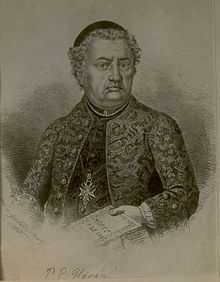Peter Pavel Glavar

Peter Pavel Glavar (2 May 1721 – 24 January 1784) was a Carniolan Roman Catholic priest, beekeeper, writer, and businessman.
Glavar was born in Ljubljana and was an illegitimate and abandoned child of the Maltese noble Pietro Giacomo de Testaferrata and of a local servant.[1][2] He was raised in Vopovlje in northern Carniola.[1] As he was a quick learner, he went to study for a priest to Ljubljana and about 1738 to Graz, where he became a master of liberal arts (Latin: magister artium liberalium).[2] There he also got acquainted with economic theories of French physiocrats. His education was wide and he was fluent in several European languages.[1]
Glavar returned to Carniola around 1743.[2] He settled in Komenda in the northern Carniola, where he established a school in 1751, and erected a benefice building with a library in 1752.[3] The library still stands and comprises around 2000 books from a multitude of fields of science and arts.[1][3] A mighty lime tree in Komenda was presumably planted by Glavar in 1748 and has been named after him.[4] Glavar collaborated with artists and ordered Franc Jelovšek to paint the beneficiary house and the local church.[3] From 1754 until 1760,[5] he edited the first Slovene-language parish family book, writing the data about the inhabitants of Komenda.[1] In 1761–66, he erected a High-Baroque church of St. Anne in Tunjice.[6]
In 1766, Glavar bought Lanšprež Castle (German: Landspreis) in Gomila near Mirna in the central Carniola,[2] where he kept an apiary with about 200 quite profitable hives.[1] He also established a beekeeping school there and wrote several texts on beekeeping, including Pogovor o čebelnih rojih (Discussion About Bee Swarms) from 1776–78, which was the first Slovene-language scholarly text, but was lost and was published only in 1976.[7] He was a supporter of poor students.[1] He died at Lanšprež Castle aged 62 years. His assets were distributed among the poor and used for the establishment of Glavar Hospital in Komenda in 1804.[1]
In 2006, a TV-documentary was produced about Peter Pavel Glavar.[3]
References
| Wikimedia Commons has media related to Peter Pavel Glavar. |
- ↑ 1.0 1.1 1.2 1.3 1.4 1.5 1.6 1.7 "GLAVAR, Peter Pavel". Gorenjci.si (in Slovenian). City Library of Kranj. Retrieved 22 July 2012.
- ↑ 2.0 2.1 2.2 2.3 Glonar, Joža (1925–1991 (printed ed.). 2009 (electronic ed.)). "Glavar Peter Pavel". In Vide Ogrin, Petra (electronic ed.). Cankar, Izidor et al. (printed ed.). Slovenski biografski leksikon (in Slovenian). ISBN 978-961-268-001-5. Check date values in:
|date=(help) - ↑ 3.0 3.1 3.2 3.3 "Filmski portret Petra Pavla Glavarja" [A Film Portrait of Peter Pavel Glavar]. MMC RTV Slovenija. 10 December 2006. ISSN 1581-372X.
- ↑ Šmid Hribar, Mateja. "Glavarjeva lipa". In Golež, Gregor; Podjed, Dan; Kladnik, Drago; Erhartič, Bojan; Pavlin, Primož; Ines, Jerele. Enciklopedija naravne in kulturne dediščine na Slovenskem – DEDI [Encyclopedia of Natural and Cultural Heritage in Slovenia] (in Slovenian). Retrieved 22 July 2012. Missing
|last1=in Editors list (help) - ↑ Demšar, Viktorijan (1979). "Prebivalci Komende po družinski knjigi Petra Pavla Glavarja" [The Inhabitants of Komenda as Described in the Family Book by Peter Pavel Glavar]. Kronika: časopis za slovensko krajevno zgodovino [The Chronicle: the Newspaper for the Slovenian History of Places] (in Slovenian) (Association of Slovenian Historical Societies, Section for the History of Places) 27 (1). ISSN 0023-4923.
- ↑ Vidrih, Rebeka. "Cerkev sv. Ane v Tunjicah". In Šmid Hribar, Mateja; Golež, Gregor; Podjed, Dan; Kladnik, Drago; Erhartič, Bojan; Pavlin, Primož; Ines, Jerele. Enciklopedija naravne in kulturne dediščine na Slovenskem – DEDI [Encyclopedia of Natural and Cultural Heritage in Slovenia] (in Slovenian). Retrieved 22 July 2012.
- ↑ Ciraj, Marta (2011). "Pogovor o čebelnih rojih". In Šmid Hribar, Mateja; Golež, Gregor; Podjed, Dan; Kladnik, Drago; Erhartič, Bojan; Pavlin, Primož; Ines, Jerele. Enciklopedija naravne in kulturne dediščine na Slovenskem – DEDI [Encyclopedia of Natural and Cultural Heritage in Slovenia] (in Slovenian).